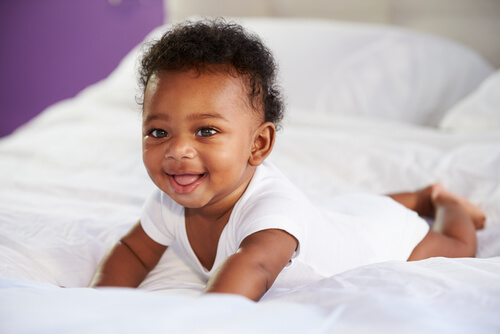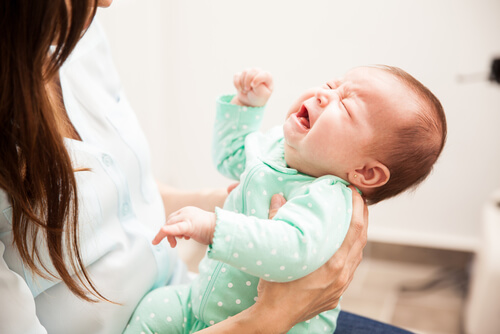What is My Baby Trying to Say When She Smiles or Cries?
Feb 14, 2022 We don’t always think of them as being particularly essential but smiling and crying are two very significant methods of communication that your baby utilizes to interact with you from the moment they are born.
Smiling isn’t merely “cute,” and crying isn’t necessarily something that only has negative connotations associated with it. Your baby uses these two fundamental mechanisms of communication as their mind develops. It’s up to you to understand what role they play in communication. Then, encourage your baby to use them more often to improve their communication skills.
Why Smiling is Important for Communication
Social smiling is essential for your baby’s overall development (especially their social and emotional development). This is an intentional gesture of warmth and communication. As well, smiling fosters bonding and attachment between you and your baby, which helps them feel both secure and safe.
Smiling Development and Milestones
Smiles and frowns are some of the first ways your baby relates to you. You’ll have noticed your baby smile relatively soon after birth and in their sleep; however, this is simply a physical motion that comes with them learning how to manipulate their bodies. They’re reflex smiles that start to occur even before your baby is born!
Your baby’s first social smile should occur around 2-3 months of age when their reflex smile disappears. However, it can start to develop as early as six weeks of age. You can tell the difference between a reflex smile and a social smile by the timing and duration of the smile itself:

- Reflex smiles tend to be shorter and occur randomly, especially when your baby is sleepy or tired;
- Social smiles arise in response to a change in the environment or a communication attempt. You will see “emotion” in a real, social smile.
Your baby’s first genuine smile is a beautiful indicator of their development. It’s a sign that their vision is improving, that they can now recognize your face, and that they are learning to attend to certain people and stimuli. This also means that your baby’s smile has moved beyond the reflexive stage and they are now aware that their smiling is a way they can connect with others. Now, your baby will smile to express pleasure, excitement, contentment, and happiness.
Your baby’s first genuine smile is a beautiful indicator of their development.
You’ll notice that as your baby grows and their vision improves, they will begin to smile more and in different situations. At about five months of age, they will start cooing and adding sound effects to their smiles, especially when they begin to laugh and feel excitement.
Tips to Develop Communication through Smiling
By encouraging your baby to smile, you are helping them develop their self-esteem by validating that their feelings are important and that they can have a direct effect on the people around them. In essence, your baby begins to realize that they are important enough to affect their environment.
Some tips to get your baby smiling:
- Choose a time of day where your baby is happiest and most content;
- Hold your baby with their face very close to yours (this is important because your baby can only see things 8 – 12 inches away at this age);
- Smile widely and say “hello” in a pleasant sing-song pitch which is commonly known as “baby talk”;
- Talk to your baby as much as possible and give them time to respond with a smile;
- Make frequent eye contact and smile at your baby throughout the day;
- Don’t be afraid to get silly – make funny faces and noises or even play a game of peek-a-boo.
Don’t worry if this doesn’t work at first. All children develop at different rates, so persevere, keep trying, and you’ll surely be rewarded with an award-winning smile in no time!
Looking for more activities to make your baby smile? Check out this fantastic blog post by Isadora Fox for ideas. Oh, and we have to understand both smiling and crying to truly know what our little ones are trying to say.
Boost Your Child’s Speech Development!
Improve language & communication skills with fun learning!

Why Crying is Important for Communication
A crying baby can be quite a worrisome thing. Parents always want to know that their baby is alright, and crying often causes them to think that something is wrong. But did you know that in the first few months of their life, crying is the most effective and foolproof way that your child has for communicating with you?
Crying Development and Milestones
Babies cry for many reasons – one of which is to capture your attention to communicate and express their needs. There are seven common reasons why your baby cries. Here’s a breakdown of how these cries sound and what action your baby requires you to take when you hear them:
Tips to Understand Your Child’s Communication through Crying
Paying attention to your child’s cries are one of the best things you can do to develop their communication skills. Each baby has different sensory needs, and babies first experience their world through different sensations. You need to get to know your baby’s preferences by monitoring their senses and figuring out how they respond to certain stimuli by the kind of crying they do. To understand the particular kind of baby cry meaning, you can check your baby’s:
- Mood changes;
- Reactions to different situations, environments, and events;
- The differences in their cries.
Monitoring your baby’s cries and how they differ is the best way to help develop your child’s communication. At first, all of your baby’s cries will sound the same; however, you will gradually learn to hear and tell the difference between the cries and what your baby is communicating through them – crying becomes the language through which your baby learns to communicate with you.

For example, you will learn to tell the difference between an “I’m hungry cry” and an “I’m tired” cry. Knowing the difference will help you respond appropriately, which will teach your baby that their communication has meaning and that it ultimately delivers a result.
Noticing the noise level, pitch, and intensity of the cry will help you learn what your baby is wanting, and you can buffer this knowledge by observing their body language and facial expressions as well.
Remember Smiling and Crying are ways to communicate
Responding to your baby’s smiling and crying validates their communicative intent and encourages them to communicate more.
You always have an ally with Speech Blubs, and you can download our Speechblubs app to help stimulate your child and elicit plenty of smiles while working on some of our fantastic communication-centered activities. You can even contact us for additional support if you’re not sure what your next steps should be.

